Birdfinding.info ⇒ Globally declining due to the cagebird trade, but still locally common in several parts of its range. Areas where it can often be found include: in Colombia, Altagracia, Hato La Aurora, and Los Flamencos; in Venezuela, Falcón National Park and Laguna de Unare; in Brazil, Canudos and the Pantanal around Miranda and Poconé; in Argentina, throughout the Chaco region and Andean foothills from Salta to La Rioja, the hill country of Córdoba, and eastern La Pampa (e.g., Parque Luro Reserve); in California, Point Loma Heights and La Mesa; in Florida, Anna Maria Island (Bradenton), Wickham Park (Melbourne), Richardson Park (Fort Lauderdale), and Topeekeegee Yugnee Park (Hollywood); on Curaçao, Sint Michiel; and in Lisbon, most city parks (e.g., Bensaúde, Eduardo VII, Quinta das Conchas, and d’Ajuda). The Bolivian highland form, neumanni (“Bolivian Parakeet”), can be found at several points along the highway west of Santa Cruz de la Sierra from Samaipata to Omereque and the Serranía de Siberia, and in the Monte Willca Natural Area north of Sucre.
Blue-crowned Parakeet
Thectocercus acuticaudatus
Dry savannas and brushlands of South America; introduced elsewhere.
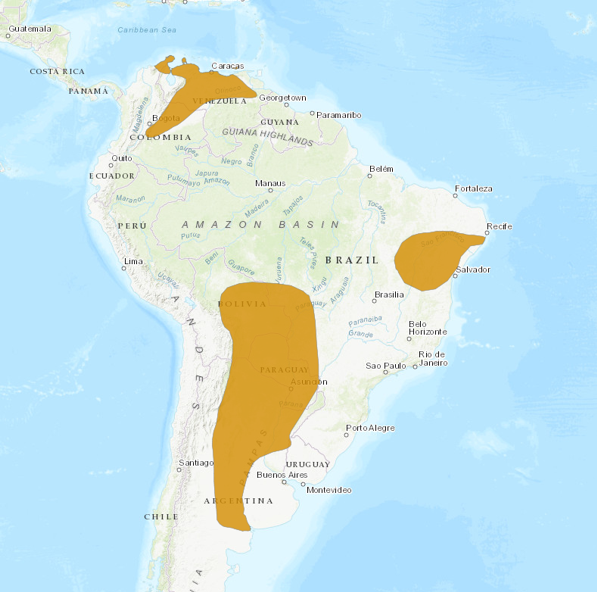
Approximate natural range of the Blue-crowned Parakeet. © BirdLife International 2018
Inhabits four distinct regions: (1) acuticaudatus in the south-central interior from Bolivia and Mato Grosso to central Argentina; (2) neumanni (a potentially distinct form, the “Bolivian Parakeet”) on the Andean plateau in central Bolivia; (3) haemorrhous in the caatinga biome of northeastern Brazil; and (4) koenigi in the coastal scrub, brushland, and Llanos of northeastern Colombia and Venezuela.
In the south-central interior, widespread from northeastern Bolivia and southern Mato Grosso south throughout the Chaco, Panatanal, and foothills and plains of western and central Argentina south to the Pampas of northeastern Río Negro and southwestern Buenos Aires Province
In the eastern Andes of central Bolivia, at elevations of around 1,500 to 2,650 m, in parts of Cochabamba, Santa Cruz, Chuquisaca, and Tarija.
In northeastern Brazil, mainly in the interior from southern Maranhão and Tocantins east to northern Bahia and south to northern Minas Gerais.
In the north, remnant populations persist in the coastal lowlands from La Guajira to Lara, separately in the Colombian Llanos, and very locally farther east in Anzoátegui, northern Bolívar, and Isla Margarita (where the subspecies neoxenus faces imminent extirpation).
Introduced populations are well established in: Curacao; three urban areas of Florida (St. Petersburg and Bradenton; Cape Canaveral to Melbourne; and the southeast from West Palm Beach to South Miami); San Diego, California (and mostly vanished from Los Angeles County during the 2010s); and Lisbon, Portugal.
Smaller populations are more tenuously established in Hawaii (around Turtle Bay, northern Oahu, since at least 2012) and Barcelona, Spain.
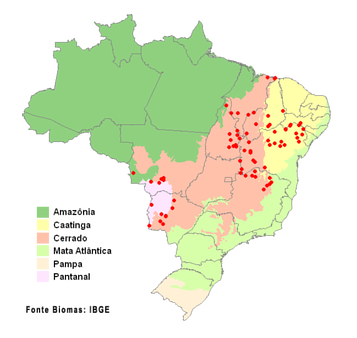
Brazilian records from © Wikiaves
Identification
A large parakeet with wide pale orbital skin, a large, mostly pinkish or ivory bill, and a variable amount of blue on the head, sometimes only on the forecrown.
The regional populations differ in the predominance of certain features: the tone and extent of blue on the head; the color of the lower mandible (dark or pale); and the color of the bare orbital skin (yellow or whitish).
The nominate acuticaudatus of the central plains typically has an extensively blue head, a blackish lower mandible, and a wide white orbital ring.
There is individual and local variation in each of these features, however, as some have subtle or limited blue on the head or a pale lower mandible (both predominant in the Pantanal area), or yellow orbital skin (common in La Pampa).

Blue-crowned Parakeet, T. a. acuticaudatus. (Teniente Enciso National Park, Boquerón, Paraguay; August 9, 2019.) © Tadeusz Stawarczyk

Blue-crowned Parakeet, T. a. acuticaudatus, showing reddish undertail. (Parque Luro Provincial Nature Reserve, La Pampa, Argentina; April 30, 2015.) © Martin Arregui
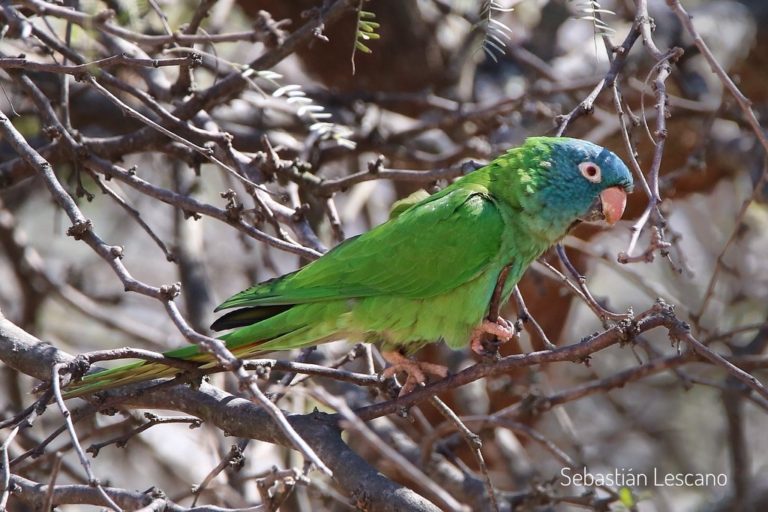
Blue-crowned Parakeet, T. a. acuticaudatus. (La Viña, Salta, Argentina; September 20, 2018.) © Sebastián Lescano

Blue-crowned Parakeet, T. a. acuticaudatus. (Topeekeegee Yugnee Park, Hollywood, Florida; May 27, 2019.) © Scott Stafford
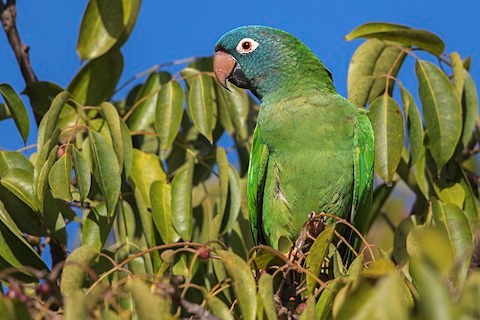
Blue-crowned Parakeet, T. a. acuticaudatus. (Richardson Historic Park and Nature Preserve, Fort Lauderdale, Florida; February 2, 2017.) © Bradley Hacker
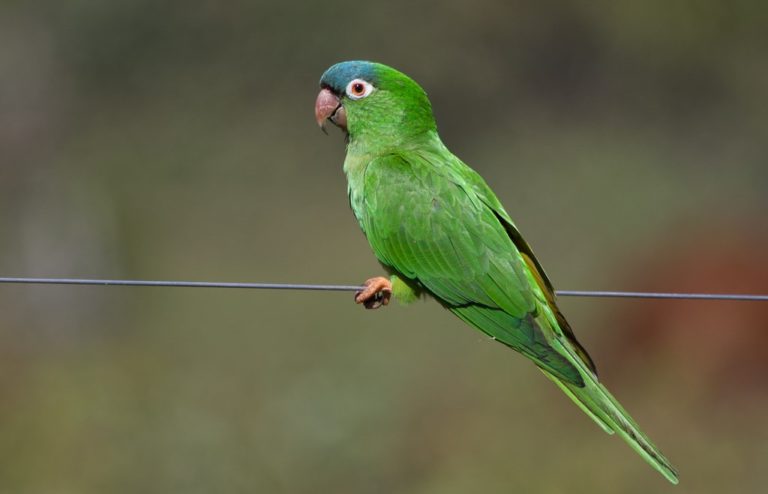
Blue-crowned Parakeet, T. a. acuticaudatus, with all-pale bill and blue limited to the forecrown, which is typical of Pantanal populations. (Poconé, Mato Grosso, Brazil; August 11, 2013.) © Wilson Lucheti
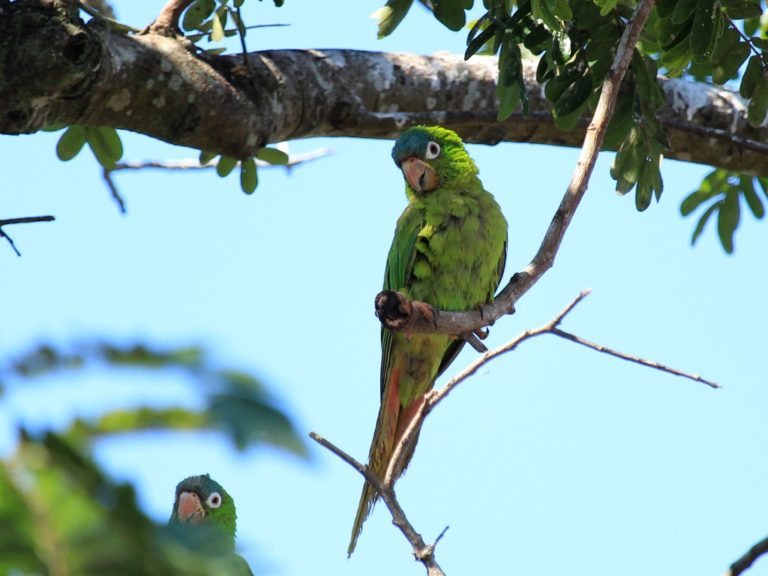
Blue-crowned Parakeet, T. a. acuticaudatus, with all-pale bill and blue limited to the forecrown, which is typical of Pantanal populations. (Corumbá, Mato Grosso do Sul, Brazil; December 18, 2018.) © Gabriel Tirintan de Lima
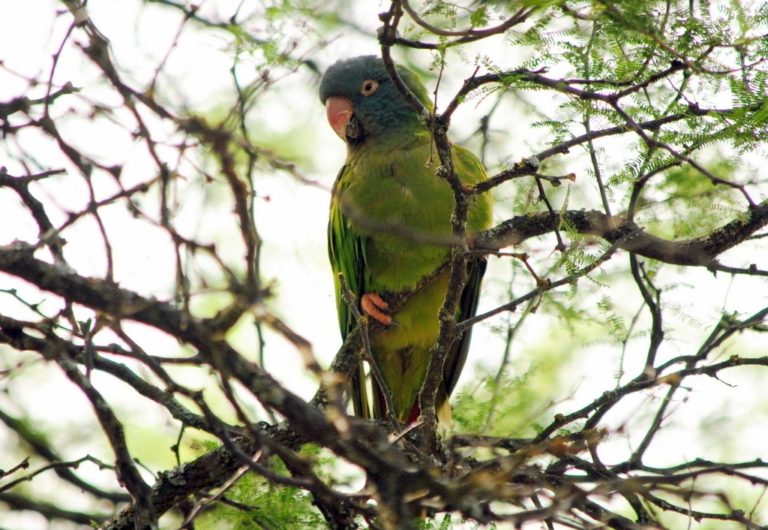
Blue-crowned Parakeet, T. a. acuticaudatus, showing yellow orbital skin, which is common in this population. (Toay, La Pampa, Argentina; December 5, 2018.) © María Belén Dri
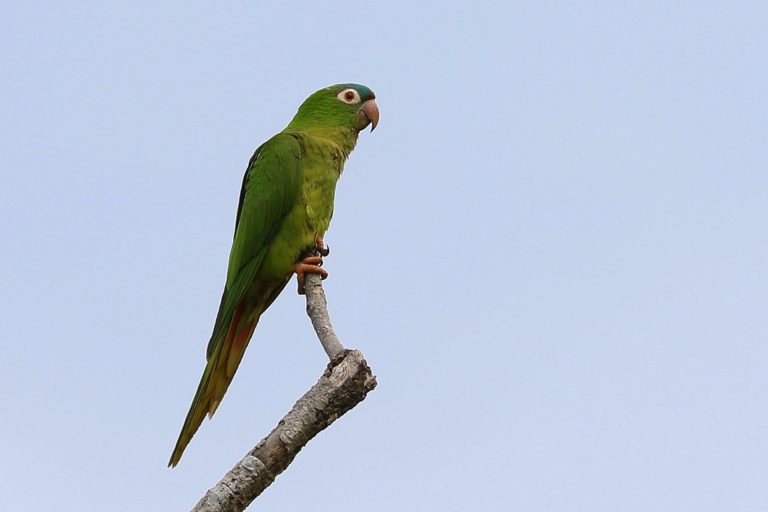
Blue-crowned Parakeet, T. a. acuticaudatus, with all-pale bill and blue limited to the forecrown, which is typical of Pantanal populations. (Poconé, Mato Grosso, Brazil; January 11, 2019.) © Leonardo Casadei
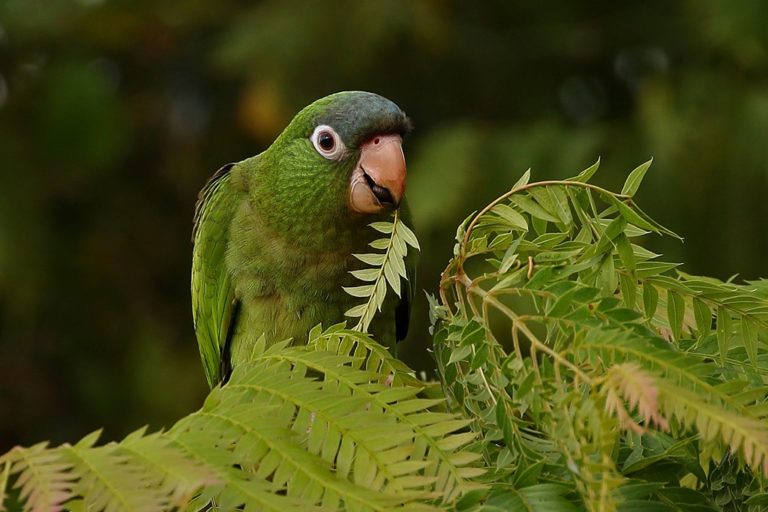
Blue-crowned Parakeet, T. a. acuticaudatus, with all-pale bill and blue limited to the forecrown, which is typical of Pantanal populations. (Poconé, Mato Grosso, Brazil; January 30, 2018.) © Rosilene Lahr

Blue-crowned Parakeet, T. a. acuticaudatus, with all-pale bill and blue limited to the forecrown, which is typical of Pantanal populations. (Poconé, Mato Grosso, Brazil; June 11, 2011.) © Thiago Calil

Blue-crowned Parakeet, T. a. acuticaudatus, with all-pale bill and blue limited to the forecrown, which is typical of Pantanal populations. (Pousada Piuval, Mato Grosso, Brazil; July 16, 2019.) © Paul Donahue
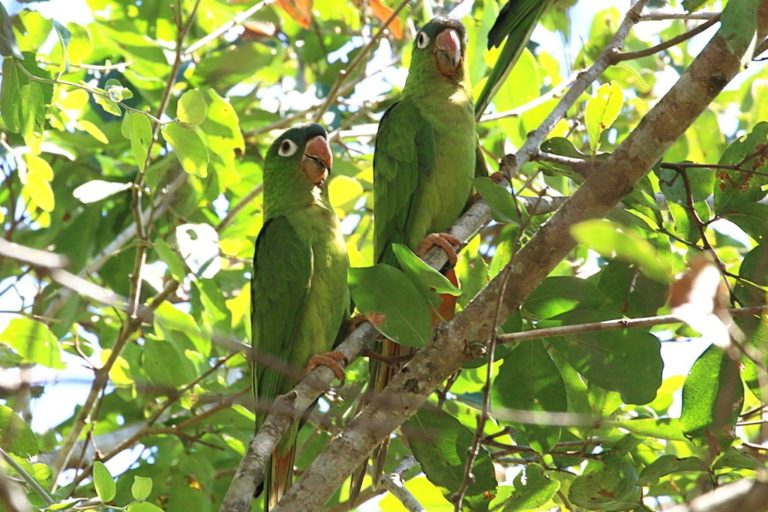
Blue-crowned Parakeet, T. a. acuticaudatus, with all-pale bills, which is typical of Pantanal populations, and showing no discernible blue on the head. (Pixaim, Poconé, Mato Grosso, Brazil; July 14, 2017.) © leithallb
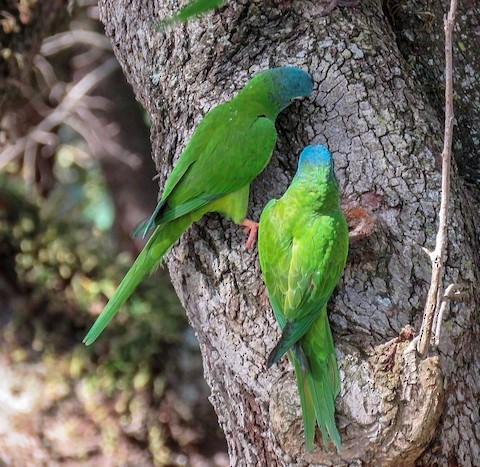
Blue-crowned Parakeet, T. a. acuticaudatus. (Topeekeegee Yugnee Park, Hollywood, Florida; January 15, 2018.) © Sam Krah
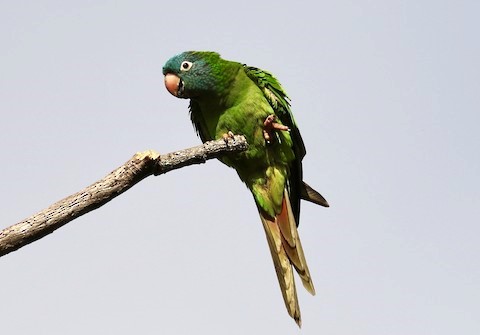
Blue-crowned Parakeet, T. a. acuticaudatus, showing bronzy-orange undertail. (Richardson Historic Park and Nature Preserve, Fort Lauderdale, Florida; January 4, 2017.) © Bill Hill
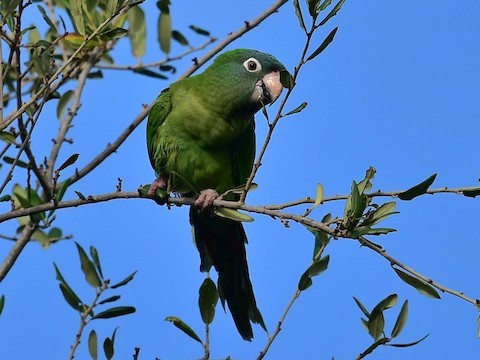
Blue-crowned Parakeet, T. a. acuticaudatus, showing only a subtle bluish tint on the head. (St. Petersburg, Florida; October 14, 2017.) © JoAnna Clayton

Blue-crowned Parakeet, T. a. acuticaudatus, showing medium-blue on forecrown and duller, darker purplish cheeks. (Quinta das Conchas Park, Lisbon, Portugal; October 1, 2019.) © Hélio Batista
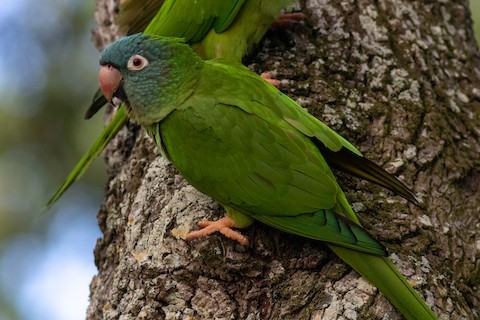
Blue-crowned Parakeet, T. a. acuticaudatus. (Topeekeegee Yugnee Park, Hollywood, Florida; March 10, 2020.) © Eric Zawatski
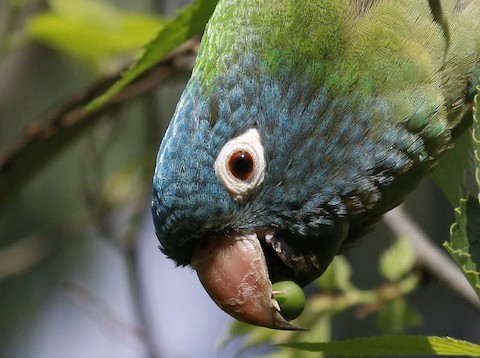
Blue-crowned Parakeet, T. a. acuticaudatus. (Quinta das Conchas Park, Lisbon, Portugal; April 12, 2020.) © Vasco Valadares
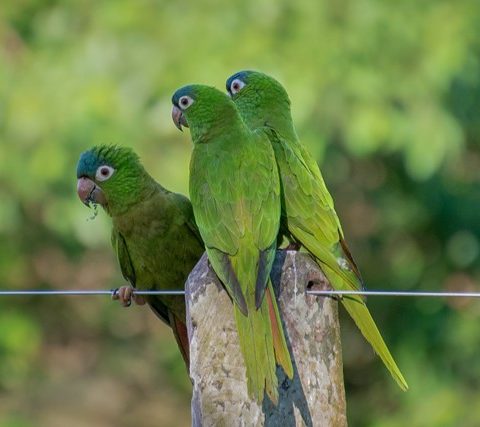
Blue-crowned Parakeet, T. a. acuticaudatus, with all-pale bill and blue limited to the forecrown, which is typical of Pantanal populations, and showing orange on inner web of outer tail feather. (Poconé, Mato Grosso, Brazil; August 21, 2014.) © Cláudio Timm
The northeast Brazilian caatinga subspecies, haemorrhous, has a subtle blue tint mostly limited to the forecrown, a pale lower mandible, and a wide white orbital ring.
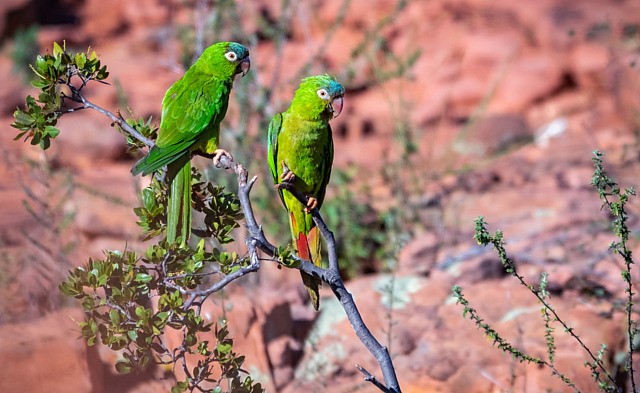
Blue-crowned Parakeet, T. a. haemorrhous, showing blue limited to forecrown, as is typical of this subspecies. (Canudos Biological Station, Bahía, Brazil; May 4, 2019.) © Julio Henrique B. Melo
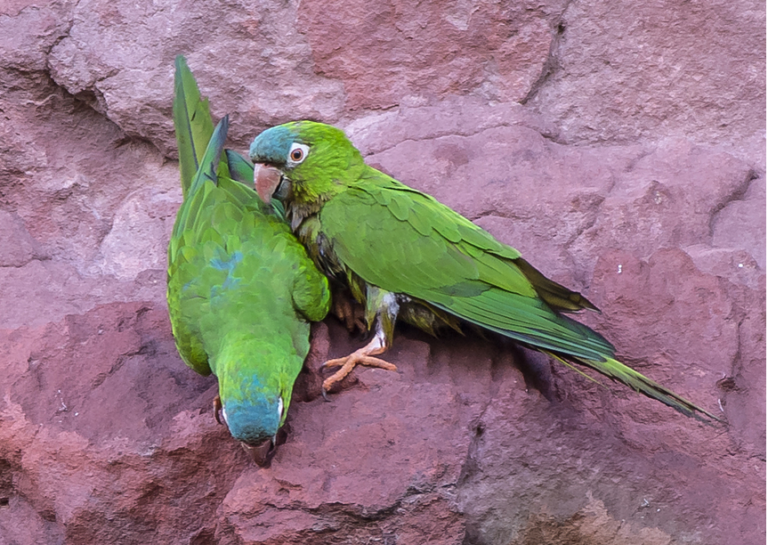
Blue-crowned Parakeet, T. a. haemorrhous, showing dark lower mandible—which is not typical of this subspecies. (Ponte Alta do Tocantins, Tocantins, Brazil; March 29, 2019.) © Roseanne Almeida
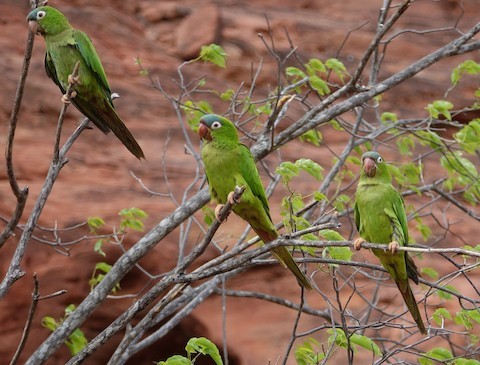
Blue-crowned Parakeet, T. a. haemorrhous, showing all-pale bills and pale blue limited to forecrown, which are typical of this subspecies. (Canudos Biological Station, Bahia, Brazil; November 29, 2018.) © Paul Bartlett
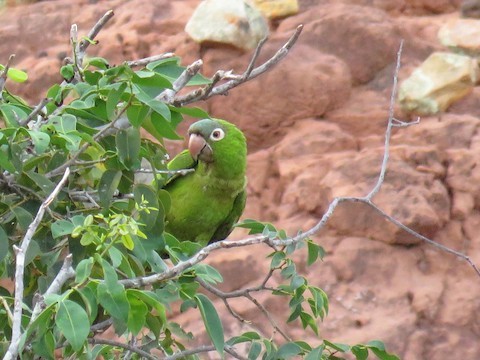
Blue-crowned Parakeet, T. a. haemorrhous, showing all-pale bill and barely discernible bluish tint on forecrown, which are typical of this subspecies. (Canudos Biological Station, Bahia, Brazil; February 6, 2019.) © Örjan Sjögren
The northern subspecies, koenigi, of Colombia and Venezuela, most resembles the Brazilian haemorrhous, generally showing limited blue on the crown and a pale lower mandible—or sometimes dusky, but rarely if ever blackish.

Blue-crowned Parakeet, T. a. koenigi, showing slightly dusky lower mandible and blue limited to forecrown, which are typical of this subspecies. (El Hatillo, Laguna de Unare, Anzoátegui, Venezuela; July 20, 2018.) © Thore Noernberg

Blue-crowned Parakeet, T. a. koenigi, showing slightly dusky lower mandible and barely discernible blue limited to forecrown, which are typical of this subspecies. (Tupuragua, Casanare, Colombia; August 3, 2020.) © Luz Ramírez

Blue-crowned Parakeet, T. a. koenigi, showing all-pale bill and no discernible blue on head. (Puerto López, Meta, Colombia; April 6, 2012.) © Oswaldo Cortes
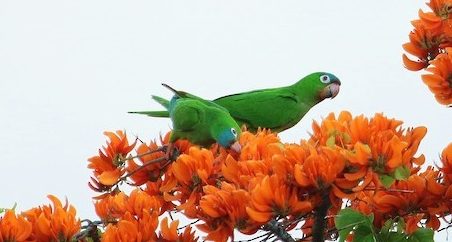
Blue-crowned Parakeet, T. a. koenigi, showing all-pale bills and blue limited to forecrown, which are typical of this subspecies. (Sierra San Luis, Falcón National Park, Falcón, Venezuela; March 31, 2015.) © Margareta Wieser
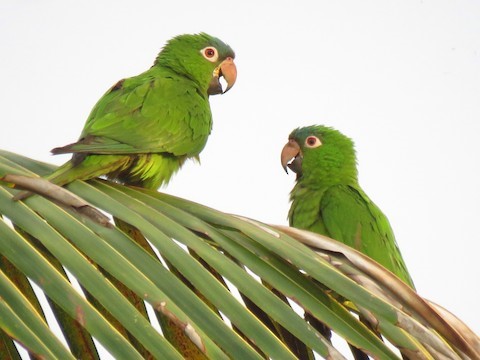
Blue-crowned Parakeet, T. a. koenigi, showing dusky lower mandible and barely discernible blue limited to forecrown, which are typical of this subspecies. (Boca de Uchire, Laguna de Unare, Anzoátegui, Venezuela; July 19, 2018.) © Thore Noernberg

Blue-crowned Parakeet, T. a. koenigi, showing dusky lower mandible and blue limited to forecrown, which are typical of this subspecies—note all-yellow undertail (with a very subtle orangish tint). (El Hatillo, Laguna de Unare, Anzoátegui, Venezuela; July 20, 2018.) © Thore Noernberg
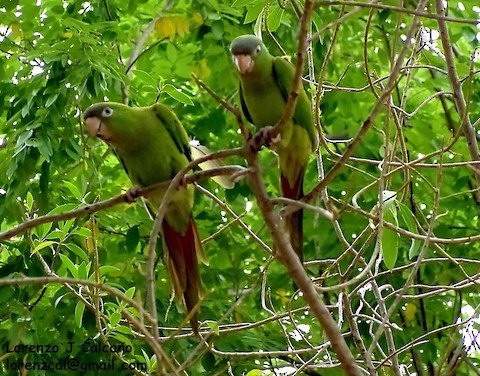
Blue-crowned Parakeet, T. a. koenigi, showing all-pale bill and barely discernible blue limited to forecrown, which are typical of this subspecies—note extensive deep-magenta on undertail. (Falcón, Venezuela; July 5, 2002.) © Lorenzo Calcaño
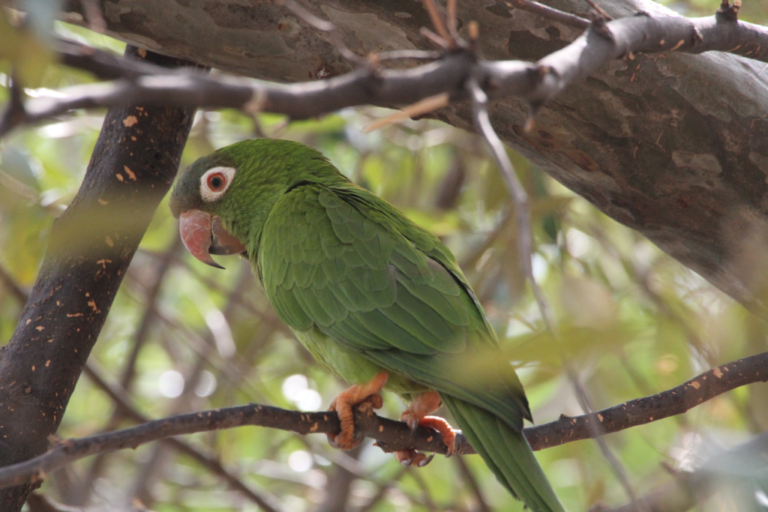
Blue-crowned Parakeet, T. a. koenigi, showing all-pale bill and blue barely discernible and limited to forecrown, which are typical of this subspecies. (Maicao, La Guajira, Colombia; May 13, 2020.) © Marc Faucher
The Bolivian highland subspecies, neumanni (sometimes recognized as a distinct form, the “Bolivian Parakeet”), has blue mostly limited to the forecrown, a blackish lower mandible, and a narrow yellow orbital ring.
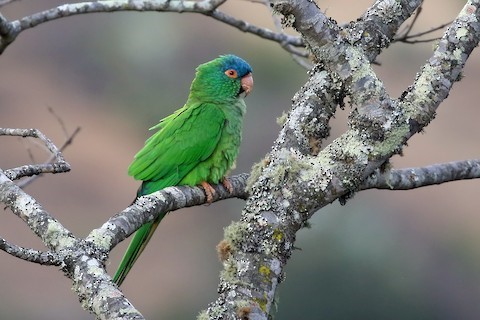
Blue-crowned (“Bolivian”) Parakeet, T. a. neumanni, showing yellow orbital skin, vivid plumage, and blue limited to forecrown, which are typical of this form. (Mataral, Santa Cruz, Bolivia; October 27, 2017.) © Phillip Edwards
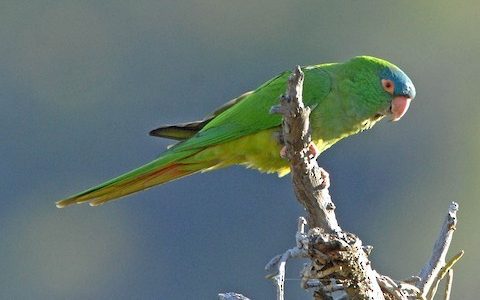
Blue-crowned (“Bolivian”) Parakeet, T. a. neumanni, showing yellow orbital skin and blue limited to forecrown, which are typical of this form. (Samaipata, Santa Cruz, Bolivia; July 28, 2011.) © Tini & Jacob Wijpkema

Blue-crowned (“Bolivian”) Parakeet, T. a. neumanni, showing yellow orbital skin and blue limited to forecrown, which are typical of this form. (Comarapa, Santa Cruz, Bolivia; July 30, 2011.) © Tini & Jacob Wijpkema

Blue-crowned (“Bolivian”) Parakeet, T. a. neumanni, showing yellow orbital skin, vivid plumage, and blue limited to forecrown, which are typical of this form. (Red-fronted Macaw Reserve, Omereque, Cochabamba, Bolivia; November 10, 2012.) © Dubi Shapiro
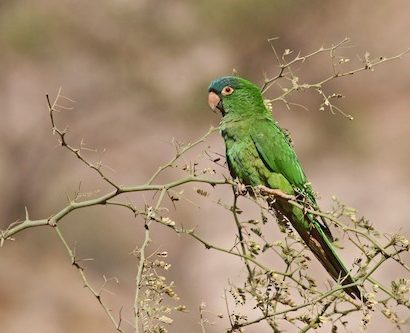
Blue-crowned (“Bolivian”) Parakeet, T. a. neumanni, showing yellow orbital skin and blue limited to forecrown, which are typical of this form. (Rio Mizque, Cochabamba, Bolivia; August 17, 2013.) © Ian Davies
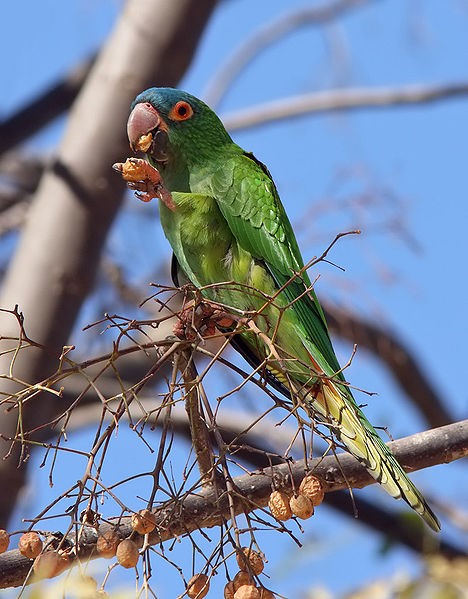
Blue-crowned (“Bolivian”) Parakeet, T. a. neumanni, showing yellow orbital skin and blue limited to forecrown, which are typical of this form. (San Isidro, Santa Cruz, Bolivia; August 26, 2009.) © Håkan Sandin
The inner webs of the outer tail feathers are usually reddish—visible mainly from below or when the tail is spread. The shade varies from yellowish-orange to magenta or maroon.
In flight, the underwings appear mostly yellow with green linings. The upperwings are essentially all-green.
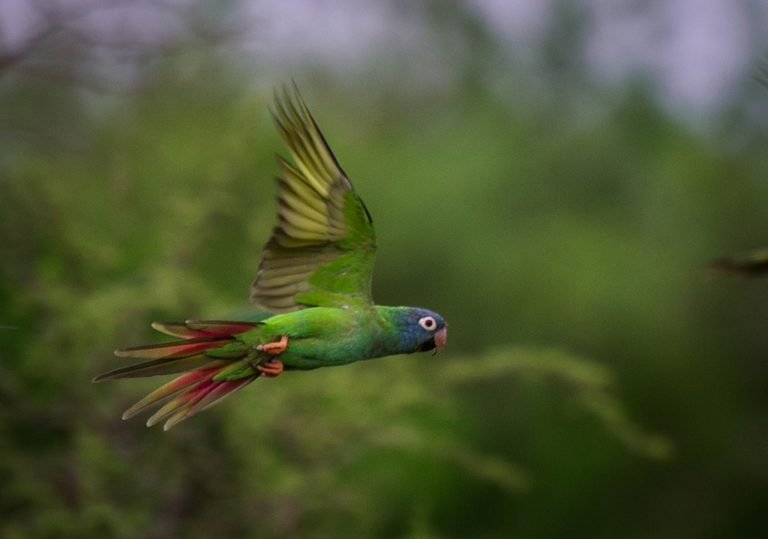
Blue-crowned Parakeet, T. a. acuticaudatus, showing green and yellow underwings and magenta on the undertail. (Corrientes, Argentina; December 6, 2016.) © Olavo Neto

Blue-crowned Parakeet, T. a. acuticaudatus. (Ituzaingó, Corrientes, Argentina; July 8, 2017.) © Marcelo Allende

Blue-crowned Parakeet, T. a. acuticaudatus. (Poconé, Mato Grosso, Brazil; September 30, 2018.) © Matthew Grube

Blue-crowned Parakeet, T. a. acuticaudatus. (Richardson Historic Park and Nature Preserve, Fort Lauderdale, Florida; March 24, 2017.) © Tom Johnson
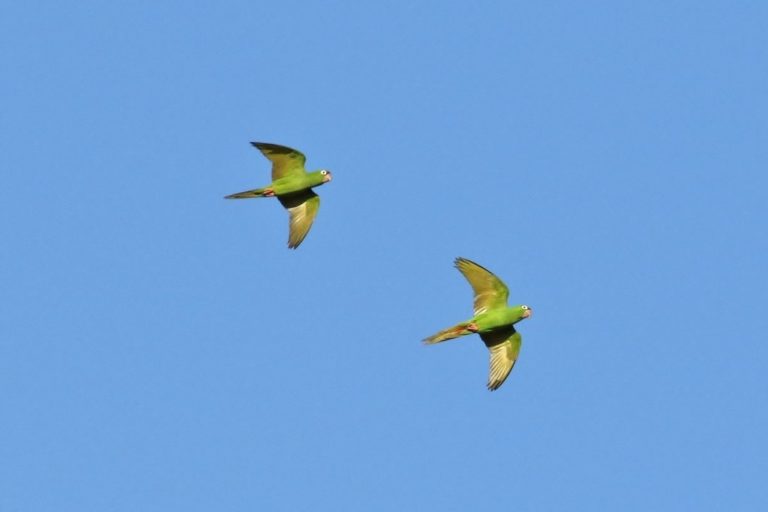
Blue-crowned Parakeet, T. a. koenigi. (La Macuira National Park, La Guajira, Colombia; January 13, 2019.) © Thibaud Aronson

Blue-crowned Parakeet, T. a. acuticaudatus, showing green and yellow underwings and magenta on the undertail. (Heron Bay, Coral Springs, Florida; November 8, 2019.) © Damon Haan

Blue-crowned Parakeet, T. a. acuticaudatus, showing green-and-yellow underwings. (Mirador del Artesano, Córdoba, Argentina; September 29, 2018.) © Jorge Schlemmer

Blue-crowned Parakeet, T. a. koenigi. (Los Puertos de Altagracia, Zulia, Venezuela; March 24, 2020.) © Lermith Torres

Blue-crowned Parakeet, T. a. koenigi. (El Limonal, La Guajira, Colombia; February 17, 2019.) © Robert Lockett

Blue-crowned Parakeet, T. a. acuticaudatus, flock showing extensive red in spread tails, with two Peach-fronted Parakeets at the lower right showing mostly yellow tails. (Poconé, Mato Grosso, Brazil; July 19, 2013.) © João Sérgio Barros
Cf. White-eyed Parakeet. Northern populations of Blue-crowned Parakeet (from Colombia to Brazil) typically have all-pale bills and often appear nearly all-green, with only a subtle bluish tint on the forecrown. In some of these areas, they may overlap with White-eyed Parakeets and are easily confused. Immatures in particular can be extremely similar. The most consistent difference is the underwing—mostly yellow with green linings on Blue-crowned, whereas White-eyed has tricolored wing linings: red, yellow, and green.
Notes
Polytypic species consisting of five recognized subspecies.
The Bolivian Andean subspecies neumanni is sometimes considered a distinct form and potential candidate for species status (the “Bolivian Parakeet”), but the basis for singling out this subspecies seems questionable. Neumanni has consistently recognizable features—especially its yellow orbital skin. However, the remaining subspecies show substantial variation and diversity of appearances that effectively encompass neumanni, including geographically distant populations that have yellow orbital skin (in La Pampa Province).
References
Alderfer, J., and J.L. Dunn. 2014. National Geographic Complete Birds of North America (Second Edition). National Geographic Society, Washington, D.C.
Ascanio, D., G.A. Rodriguez, and R. Restall. 2017. Birds of Venezuela. Christopher Helm, London.
BirdLife International. 2018. Psittacara acuticaudatus. The IUCN Red List of Threatened Species 2018: e.T22685648A132058639. https://dx.doi.org/10.2305/IUCN.UK.2018-2.RLTS.T22685648A132058639.en. (Accessed September 30, 2020.)
de la Peña, M.R., and M. Rumboll. 1998. Birds of Southern South America and Antarctica. Princeton University Press.
eBird. 2020. eBird: An online database of bird distribution and abundance. Cornell Lab of Ornithology, Ithaca, N.Y. http://www.ebird.org. (Accessed September 30, 2020.)
Forshaw, J.M. 2010. Parrots of the World. Princeton University Press, Princeton, N.J.
Juniper, T., and M. Parr. 1998. Parrots: A Guide to Parrots of the World. Yale University Press.
McMullan, M., and T. Donegan. 2014, Field Guide to the Birds of Colombia (Second Edition). Fundación Proaves de Colombia, Bogotá.
Pyle, R.L., and P. Pyle. 2017. The Birds of the Hawaiian Islands: Occurrence, History, Distribution, and Status. Version 2 (January 1, 2017). http://hbs.bishopmuseum.org/birds/rlp-monograph/. B.P. Bishop Museum, Honolulu, Hawaii.
van Perlo, B. 2009. A Field Guide to the Birds of Brazil. Oxford University Press.
Wells, J.V., and A.C. Wells. 2017. Birds of Aruba, Bonaire, and Curaçao. Cornell University Press.
Wikiaves. 2020. Aratinga-de-testa-azul, https://www.wikiaves.com.br/wiki/aratinga-de-testa-azul. (Accessed September 30, 2020.)
Xeno-Canto. 2020. Blue-crowned Parakeet – Thectocercus acuticaudatus. https://www.xeno-canto.org/species/Thectocercus-acuticaudatus. (Accessed September 30, 2020.)
